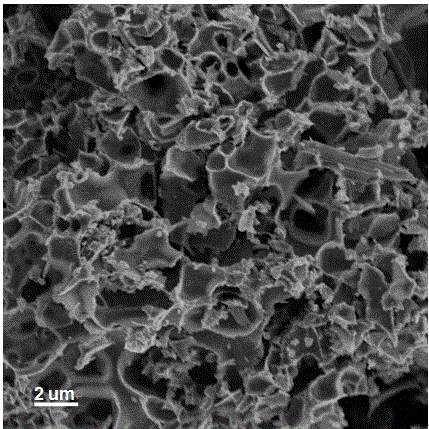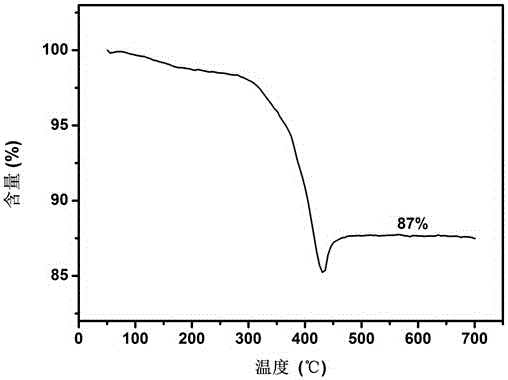Molybdenum disulfide-carbon three-dimensional porous network composite and preparation method thereof
A molybdenum disulfide, three-dimensional porous technology, applied in the direction of electrical components, battery electrodes, circuits, etc., can solve the problems of poor interface bonding between molybdenum disulfide and graphene, insufficient three-dimensional structure stability, complex preparation process, etc., to achieve interface bonding Good, excellent shape, simple reaction process
- Summary
- Abstract
- Description
- Claims
- Application Information
AI Technical Summary
Problems solved by technology
Method used
Image
Examples
Embodiment 1
[0021] Take by weighing 3.531g ammonium molybdate, 3.045g thiourea and 8.775g sodium chloride, the mixture is dissolved in the deionized water of 50ml, with the magnetic stirrer of stirring speed 300r / min, stirring and dissolving is made into solution, then again with power Sonicate with a 400W sonicator for 15 minutes and mix well. Put the mixture in the refrigerator for 12 hours to freeze, and then place it in a freeze dryer at -50°C for vacuum drying until the mixture is dried. Grind the mixture and pass through a 150-mesh sieve, take 10g of powder and place it in the ark, put the ark in a tube furnace, pass through the Ar inert gas of 200ml / min to remove the air, then use the Ar inert gas of 200ml / min, and use 10 The heating rate of ℃ / min is raised to 750 ℃, and the temperature is kept for 2 hours for chemical vapor deposition. After the reaction is completed, it is cooled to room temperature under the protection of Ar atmosphere to obtain the calcined product A, which is ...
Embodiment 2
[0024] Take by weighing 3.531g ammonium molybdate, 2.736g thiourea and 5.85g sodium chloride, the mixture is dissolved in the deionized water of 50ml, with the magnetic stirrer of stirring speed 300r / min, stirring and dissolving is made into solution, then again with power Sonicate with a 400W sonicator for 15 minutes and mix well. Put the mixture in the refrigerator for 12 hours to freeze, and then place it in a freeze dryer at -50°C for vacuum drying until the mixture is dried. Grind the mixture and pass through a 100-mesh sieve, take 10g of powder and place it in the ark, put the ark into the tube furnace, pass through the Ar inert gas of 200ml / min to remove the air, then use the Ar inert gas of 200ml / min, and use 10 The heating rate of ℃ / min is raised to 750 ℃, and the temperature is kept for 2 hours for chemical vapor deposition. After the reaction is completed, it is cooled to room temperature under the protection of Ar atmosphere to obtain the calcined product A, which ...
Embodiment 3
[0026] Take by weighing 3.531g ammonium molybdate, 3.806g thiourea and 13.162g sodium chloride, the mixture is dissolved in the deionized water of 75ml, with the magnetic stirrer of stirring speed 300r / min, stirring and dissolving is made into solution, then again with power Sonicate with a 400W sonicator for 15 minutes and mix well. Put the mixture in the refrigerator for 12 hours to freeze, and then place it in a freeze dryer for vacuum drying at -40°C until the mixture is dried. Grind the mixture and pass through a 150-mesh sieve, take 10g of powder and place it in the ark, put the ark in a tube furnace, pass through the Ar inert gas of 200ml / min to remove the air, then use the Ar inert gas of 200ml / min, and use 10 The heating rate of ℃ / min is raised to 500 ℃, and the temperature is kept for 3 hours for chemical vapor deposition. After the reaction is completed, it is cooled to room temperature under the protection of Ar atmosphere to obtain the calcined product A, which is...
PUM
| Property | Measurement | Unit |
|---|---|---|
| radius | aaaaa | aaaaa |
| length | aaaaa | aaaaa |
| thickness | aaaaa | aaaaa |
Abstract
Description
Claims
Application Information
 Login to View More
Login to View More - R&D
- Intellectual Property
- Life Sciences
- Materials
- Tech Scout
- Unparalleled Data Quality
- Higher Quality Content
- 60% Fewer Hallucinations
Browse by: Latest US Patents, China's latest patents, Technical Efficacy Thesaurus, Application Domain, Technology Topic, Popular Technical Reports.
© 2025 PatSnap. All rights reserved.Legal|Privacy policy|Modern Slavery Act Transparency Statement|Sitemap|About US| Contact US: help@patsnap.com



